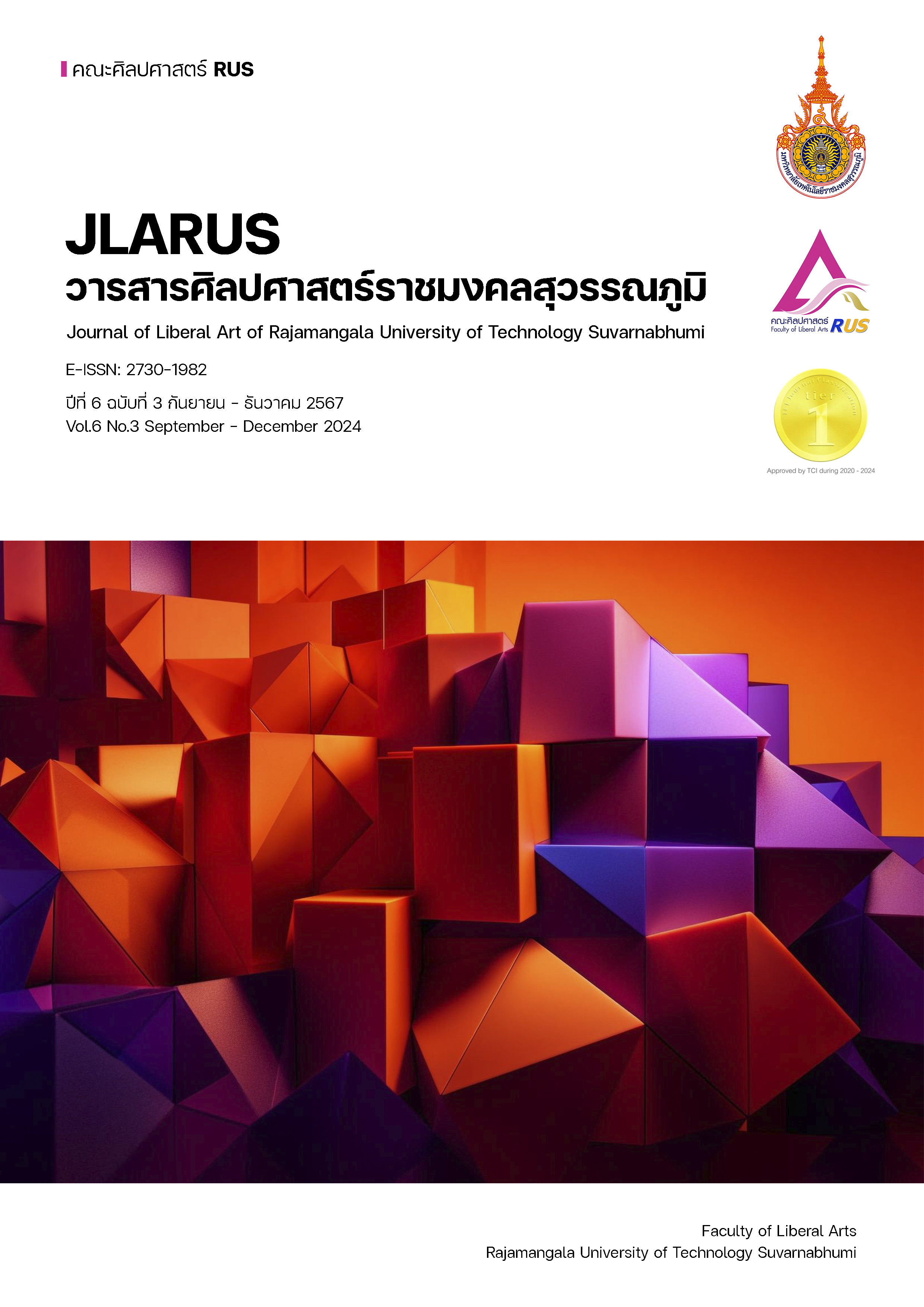INNOVATION TO IMPROVE THE EFFICIENCY OF AGRICULTURAL MACHINERY PRODUCTION SYSTEMS THROUGH COMMUNITY PARTICIPATION
Main Article Content
Abstract
This research aimed to: 1. Analyze the issues and challenges faced by S. Rungruang Machinery Company Limited's agricultural machinery production system. 2. Analyze the techniques used to address the challenges in the agricultural machinery production system of S. Rungruang Machinery Company Limited. 3. Foster ideas to improve agricultural machinery manufacturing systems through community engagement. This research was qualitative. Through comprehensive interviews and group discussions, we assessed the execution of innovative strategies. A total of 37 individuals provided imperative information.
The results of the research indicated that 1. Problems and obstacles of the agricultural machinery production system consist of four fundamental problems: 1) communication, 2) readiness of tools, machinery, and production system equipment, 3) production management, and 4) management. Guidelines for handling issues and obstacles in agricultural machinery production systems consisted of four approaches: 1) Guidelines for solving challenges in communication, 2) Guidelines for handling problems in the preparedness of tools, machinery, and equipment, 3) Guidelines for boosting process efficiency, and 4) Instructions for handling problems from management, and generating innovations to boost efficiency, developing agricultural machinery production system technology with participation from the community. It was found that there are three elements: 1) The process of developing production system technology, 2) The innovation and modernization of agricultural machinery, and 3) The ongoing development of people with creativity and unique ideas.
The research findings can help develop an innovative model that aligns with the needs of stakeholders, resulting in value creation for the target group, business value generation, technical feasibility, and customer engagement.
Article Details

This work is licensed under a Creative Commons Attribution-NonCommercial-NoDerivatives 4.0 International License.
References
จิดาภา เร่งมีศรีสุข, นภัทร์ แก้วนาค, พระครูใบฎีกาอภิชาติ พรสุทธิชัยพงศ์, สุวลังก์ วงศ์สุรวัฒน์ และพระครูปลัดประวิทย์ ทรัพย์อุไรรัตน์. (2567). นวัตกรรมวิธีวิทยาการวิเคราะห์และการสังเคราะห์ข้อมูลการวิจัยเชิงคุณภาพ. วารสารสหวิทยาการมนุษยศาสตร์และสังคมศาสตร์, 7(2), 965-980. https://so04.tci-thaijo.org/index.php/jmhs1_s/article/view/270843/183477.
วัชรพจน์ ทรัพย์สงวนบุญ และปรียากมล เอื้องอ้าย. (2563). การพัฒนานวัตกรรมของอุตสาหกรรมการผลิตเพื่อยกระดับความสามารถทางการแข่งขันองค์กร. วารสารนวัตกรรมการบริหารและการจัดการ, 8(2), 89-100. https://so02.tci-thaijo.org/index.php/RCIM/article/ view/240854.
วรัญญู ทิพย์โพธิ์, กิตติคุณ นิมิตแสงเทียน และปานจิต ศรีสวัสดิ์. (2562). การพัฒนาขีดความสามารถทางเทคโนโลยีและนวัตกรรมการผลิตเมล็ดพันธุ์ข้าวในพื้นที่จังหวัดอุบลราชธานี. วารสารบริหารธุรกิจเทคโนโลยีมหานคร, 16(1), 48-72. https://so04.tci-thaijo.org/index. php/journalmbsmut/article/view/206380.
สมนึก เอื้อจิระพงษ์พันธ์, สมหมาย ทองมี และจาตุรนต์ ชุติธรพงษ์. (2555). ความเป็นองค์กรนวัตกรรมและความสามารถทางนวัตกรรม กรณีศึกษาโรงพยาบาลเกาะสมุย. วารสารวิทยาการจัดการ, 29(2), 47-65. https://so03.tci-thaijo.org/index.php/jms_psu/article/ view/63763.
อาจหาญ กันนุลา, ศุภสิทธิ์ จารุพัฒน์หิรัญ และประยงค์ มีใจซื่อ. (2560). อิทธิพลของสมรรถนะโซ่อุปทานในฐานะปัจจัยคั่นกลางที่ส่งผลต่อกลยุทธ์การพัฒนาผลิตภัณฑ์นวัตกรรมและความสามารถทางการแข่งขันของอุตสาหกรรมการผลิตชิ้นส่วนยานยนต์ของไทย. วารสารดุษฎีบัณฑิตทางสังคมศาสตร์, 7(2),59-74. https://so05.tci-thaijo.org/index.php/ phdssj / article/view/68099.
Arnstein, S. R. (2019). A ladder of citizen participation. Journal of the American Institute of Planners, 35(4), 216-224. https://doi.org/10.1080/01944366908977225.
Berelson, D. (1952). Content Analysis in Communicative Research. The Free Press.
Chavas, J. P., Hummels, D., & Wright, B. D. (2019). The Economics of Food Price Volatility and Agricultural Trade Policy. Annual Review of Resource Economics, 11, 55-75. https://doi.org/10.7208/9780226129082.
Chen, J., & Lee, H. L. (2012). Bullwhip effect measurement and its implications. Operations Research, 60(4), 771-784. https://doi.org/10.1287/opre.1120.1074
Denzin, N.K. (1970). The research act. Aldine.
Duarte, A. L. D., & Snyder, C. A. (2006). Utilizing information technology in operations management: A case study in a manufacturing firm. Journal of Manufacturing Technology Management, 17(1), 5-17.
Goffin, K., & Mitchell, R. (2020). Innovation management: Effective strategy and implementation. Palgrave Macmillan.
Holsti, O. R. (1969). Content Analysis for the Social Science and Humanities. Addison–Wesley.
Johnson, L. (2021). Technology Adoption in Communities. Technology and Society.
Nguyen, T., & Waring, T. (2013). The adoption of customer relationship management (CRM) technology in SMEs: An empirical study. Journal of Small Business and Enterprise Development, 20(4), 824-848.
Ospina, B., Cadavid, L. F., Garcia, M., & Alcalde, C. (2002). Mechanization of cassava production in Colombia. Howeler.
Patel, C., & Sharma, R. (2021). Embracing digital transformation: Challenges and opportunities for businesses. International Journal of Digital Innovation, 8(1), 20-30.
Prajogo, D. I., & Sohal, A. S. (2006). The integration of TQM and technology/R&D management in determining quality and innovation performance. Omega, 34(3), 296-312. https://doi.org/10.1016/j.omega.2004.11.004.
Pretty, J. (1995). Participatory learning for sustainable agriculture. World Development, 23(8), 1247-1263. https://doi.org/10.1016/0305-750X(95)00046-F.
Rowe, G., & Frewer, L. J. (2018). A typology of public engagement mechanisms. Science, Technology, & Human Values, 30(2), 251-290. https://doi.org/10.1177/ 016224390427172.
Schilling, M. A. (2020). Strategic management of technological innovation. McGraw-Hill Education.
Shah, R., & Ward, P. T. (2003). Lean manufacturing: Context, practice bundles, and performance. Journal of Operations Management, 21(2), 129-149. https://doi.org/10.1016/S0272-6963(02)00108-0.
Tidd, J., & Bessant, J. (2020). Managing innovation: Integrating technological, market and organizational change. John Wiley & Sons.
Torfing, J., Sørensen, E., & Røiseland, A. (2020). Transforming the public sector into an arena for co-creation: Barriers, drivers, benefits, and ways forward. Administration & Society, 51(5), 795-825. https://doi.org/10.1177/0095399716680057
Wang, L., & Qualls, W. (2007). Towards technology innovation for the supply chain: A conceptualization and case study. International Journal of Technology Management, 37(1-2), 145-160.
West, J., & Bogers, M. (2021). Open innovation: Current status and research opportunities. Innovation: Organization & Management, 23(1), 34-40. https://doi.org/10.1080/14479338.2016.1258995.
Zhang, Y., Wang, H., Luo, Y., & Zhao, J. (2020). Application of Artificial Intelligence in the Agricultural Sector. IEEE Access, 8, 36298-36310.
Zhang, Q. (2015). The future of precision agriculture. Journal of Agricultural and Food Chemistry, 63(46), 10442-10444. http://dx.doi.org/10.12785/ijcds/1401112.


